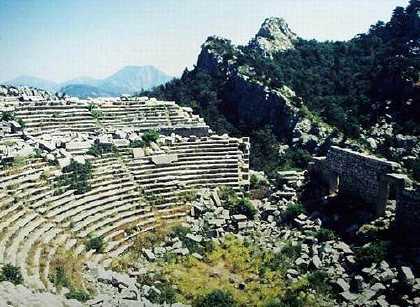The "Unities"
Greek and Latin plays were very different from the native traditions of drama that the young Shakespeare might have come across if he had seen a mystery cycle, or watched the travelling troupes of actors who came to Stratford, performing moralities or the various types of drama which developed from them. (Click to read about the Greek theatre* pictured here.)
Greek and Latin drama were strict in form. The stage represented a single place throughout the action; the plot recounted the events of a single day; and there was very little irrelevant by-play as the action developed. Aristotle described the drama of an earlier age in his important work On the Art of Poetry; those who followed his precepts called this disciplined structure the three "unities": unity of place, unity of time and unity of action.
The "Rules"
Neo-classical Renaissance critics codified Aristotle's discussion, claiming that all plays should follow these three precepts:
Place. The setting of the play should be one location: in comedy often a street, in Oedipus Rex the steps before the palace.
Time. The action of the play should represent the passage of no more than one day. Previous events leading up to the present situation were recounted on stage, as Prospero tells Miranda of the events which led to their abandonment on the island.
Action. No action or scene in the play was to be a digression; all were to contribute directly in some way to the plot.
Compare this structure with the episodic, wide-ranging plots of romantic comedy like Shakespeare's Winter's Tale.
Footnotes
-
The theatre illustrated
The theatre shown here is a Greek one, modified by the Romans, in what is now Turkey. The Greek theatre was a more complete circle; the Romans reduced the theatre to a semicircle with a "backstage" area.
Click for a view of a theatre at Ephesus, also in Turkey; Shakespeare's early Roman-style comedy The Comedy of Errors is set in Ephesus.
